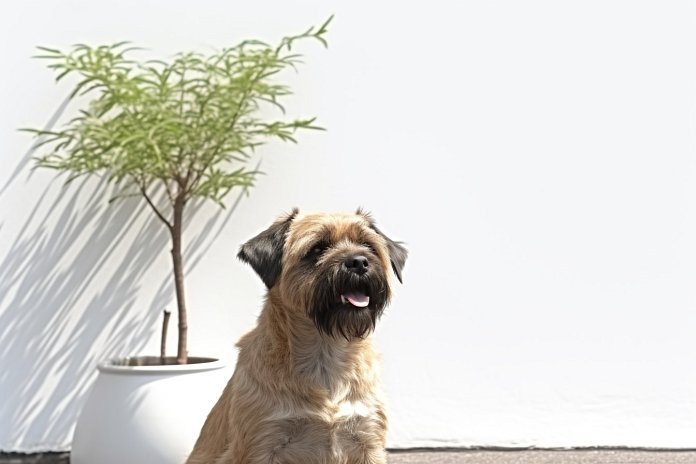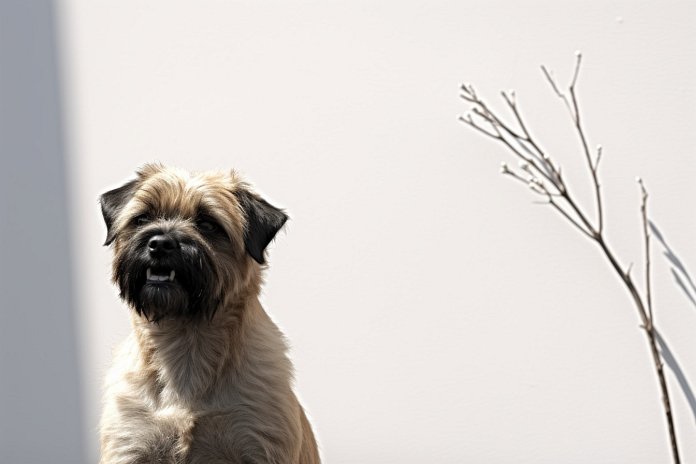
Border Terriers are friendly and make excellent companions. Originally bred to help with fox hunts, they would flush out the fox from its den and chase it down. The Border Terrier is one of the oldest Terrier breeds in Britain and is known for its high energy levels and strong hunting instincts. They are best suited for families that can provide them with plenty of activities to keep them busy. Their rough coat should be brushed once a week and it is recommended to have them professionally groomed a few times a year.
In summary, Border Terriers are friendly and energetic dogs that were originally bred for fox hunting. They require regular exercise and stimulation to keep them happy. Their coat needs regular maintenance and occasional professional grooming.
Ahead, we look at Border Terrier dog breed, its history, personality, pros and cons of owning an Border Terrier, characteristics, and must-see facts. We will also examine how to care for this breed and much more. Prepare for a tail-wagging adventure into the world of Border Terriers!
| Dog Breed | Border Terrier |
| Size | Small |
| Weight | 11-14 lbs (average) |
| Height | 10-11″ (average) |
| Location | Border of Scotland and England |
| Ancestry | dandie dinmont terrier, bedlington terrier |
| Date of Origin | 1700s |
| Group | Fox Bolting, Ratting |
| Life Expectancy | 11-15 years |
| Price | $1200 – $1400 |
| Family | Canidae |
| Scientific Name | Canis Lupus Familiaris |
📖 Breed History
Originally, the Border Terrier was known as the Coquetdale Terrier or Redesdale Terrier, named after the areas where the breed originated. However, in the 1800s, the name was changed to Border Terrier due to its association with the Border Hunt in Northumberland. The Border Terrier is believed to be related to Bedlington Terriers and Dandie Dinmont Terriers, which also originated from the same region. These dogs were developed by farmers and shepherds from the border of England and Scotland to help control the fox population, as foxes were posing a threat to farm animals.
During the 19th century, foxhunting became a popular sport. The Border Terrier played an important role in this activity, running alongside horses and hounds. They needed to have legs of the right length to keep up with the chase but also short enough to fit inside the fox’s den. Despite their small size, Border Terriers were known for their determination, intelligence, and hardworking nature. The breed gained popularity when it was officially recognized as a distinct breed by the English Kennel Club and later registered with the American Kennel Club in 1930. Border Terriers have also made appearances in various films and television series, further increasing their popularity. Today, they have transitioned from being working farm dogs to becoming beloved pets and show dogs.

🐕 Border Terrier Appearance
The otter-like head of the Border Terrier is characteristic. They have a short, dark-colored snout and a wide cranium. Their short, coarse hair might be red, blue, tan, wheaten, grizzle and tan, or tan and tan. They have tiny, sharp eyes that have a hint of mischief about them. They have little, “V”-shaped ears that are folded and have black noses. The Border Terrier has a scissor bite, robust teeth, and a few sparsely-furred hairs on its muzzle. The tail’s base is thick and relatively short. The Border Terrier has a short, thick double coat. They have a thick, dirt-repellent outer coat and a velvety undercoat. They have tiny, little feet with robust pads. They have powerful rear legs.
| 👀 Eye Color | Brown |
| 🐽 Nose Color | Black |
| 🐕 Coat Color | Black, Gray, Red, Cream, Blue, Brindle |
⚡ Fun Fact: Border Terrier dogs need for social interaction is average. This breed likes being around people or other animals, but they don’t mind being left alone for a few hours either.
🐶 Traits & Temperament of Border Terrier
Border Terriers have a strong prey drive because of their ancestry. They may chase and possibly even attack smaller creatures like cats, squirrels, rats, rabbits, and hamsters if they are not properly socialized as young animals. Most Border Terriers don’t get along with other dogs of the same sex. Border Terriers are intelligent canines who like taking part in entertaining activities. Border Terriers are readily trained but can be difficult to control. They respond effectively to constructive criticism rather than severe punishment. In agility training, the Border Terrier performs admirably. They like having a purpose because they are a working breed. New toys to chew on and play with make the Border Terrier very pleased. Children may have great companionship with Border Terriers. They can, however, be a little too spirited for young youngsters.
🤝 Are Border Terriers Friendly or Aggressive?
Border Terrier dogs typically do not get along with other pets and are not particularly friendly towards strangers. However, they are known to be very good with children and enjoy being in their company. On the other hand, Border Terriers may not be the best choice for households with cats or if you want to have multiple dogs or participate in dog meetups. Despite these factors, Border Terriers are considered one of the top breeds for elderly individuals, likely due to their temperament and size.
This breed is known for being:
- Alert
- Intelligent
- Affectionate
- Obedient
- Outright
- Tempered
- Fearless
🐩 Border Terrier Care & Maintenance
Every week, the Border Terrier’s coat has to be brushed. A few times per year, the outer coat will need to be manually stripped to eliminate dead hair. The Border Terrier sheds very little to none, making them suitable as pets for allergy sufferers. The Border Terrier doesn’t need to be bathed frequently. It is advised to use a shampoo made for a Terrier’s coat while bathing a Border Terrier. The Border Terrier breed may be content to live in either an apartment or a house if given the regular activity it requires due to its high energy level. They take pleasure in difficulties presented by both physical and mental endeavors. The Border Terrier may avoid boredom by playing with exciting hide and seek toys. Border Terriers can develop a barking habit if left alone for prolonged periods of time with minimal activity. Given that they are adept escape artists, it is crucial to maintain a secure backyard. Their inclination to dig might take over if they are left in an unattended yard.
Border Terrier dogs are known for their minimal shedding or even no shedding at all. This means that if you have a puppy from this breed, you don’t have to worry about your furniture or car being covered in dog hair. If you have a low tolerance for dog hair, then a Border Terrier dog could be the perfect choice for you. Additionally, these dogs typically only need to be bathed every 4-6 weeks.
🍖 Food: We recommend 1 cups daily, costing you about $1.00 – $1.25 daily, or approximately $25.00 – $30.00 a month.
🐾 Exercise: Border Terrier dogs have an average exercise need. This breed is satisfied with short walks every weekday and a long ones on weekends.
This dog breed requires to be walked for roughly 10 miles per week, which equates to about 60 minutes of physical activity daily. This consistent moderate exercise regimen will help maintain their physical wellness and significantly contribute to their mental stimulation. Consciously setting aside this time for your furry friend can dramatically enhance their life quality, helping them stay energetic, healthy, and mentally alert.
Did you know: Border Terrier dogs have a higher energy level than other dog breeds. If you want a dog for snuggling on the couch, this breed isn’t the perfect choice for you.
❤️🩹 Border Terrier Health & Issues
Some of the major concerns for Border Terrier Dog Breed can be:
- Cataracts
- Retinal Dysplasia
While minor concerns include:
- Progressive Retinal Atrophy
- Fanconi Syndrome
🤧 Important: Is Border Terrier hypoallergenic? Yes.
✨ Bonus: Check out cool, creative, and funny names for Border Terrier.
⚡ Border Terrier Dog Breed Facts
What makes the Border Terrier a great choice for families with young children?
The Border Terrier is a great choice for families with young children because they are good-natured and can make excellent companions. However, they can be a bit too spunky for small children.
Is the Border Terrier breed considered a suitable breed for apartment living?
The Border Terrier breed is considered suitable for apartment living as long as they receive sufficient exercise and mental stimulation.
How much exercise does a Border Terrier require compared to other breeds?
Border Terriers require a moderate amount of exercise compared to other breeds. They are high-energy dogs and enjoy activities such as walks, playtime, and agility training.
Is the Border Terrier breed known for being good with other pets?
Border Terriers have a high prey drive and may not do well with other pets, especially smaller animals like cats, squirrels, rats, rabbits, and hamsters.
What are other low-maintenance dog breeds similar to the Border Terrier?
Some low-maintenance dog breeds similar to the Border Terrier include the Boston Terrier, Cavalier King Charles Spaniel, and Shih Tzu.
What are the common health issues that Border Terriers are prone to?
Common health issues that Border Terriers are prone to include allergies, hip dysplasia, heart problems, and certain genetic conditions like progressive retinal atrophy.
Are Border Terriers known to be easy to train compared to other breeds?
Border Terriers are known to be intelligent and can be easily trained. However, they can also be stubborn at times and do best with positive reinforcement methods.
Are Border Terriers more prone to separation anxiety compared to other breeds?
Border Terriers can be prone to separation anxiety, but this can vary from dog to dog. Proper socialization and training from a young age can help prevent or minimize separation anxiety.
Are there any dog breeds similar to the Border Terrier that are suitable for people with allergies?
Some dog breeds similar to the Border Terrier that are suitable for people with allergies include the Bichon Frise, Poodle, and Maltese.
What sizes of dogs similar to the Border Terrier are best for individuals or families with limited space?
Small-sized dogs similar to the Border Terrier, such as the Shih Tzu, Cavalier King Charles Spaniel, and Boston Terrier, are best for individuals or families with limited space.
Is the Border Terrier breed known to be good with children with special needs?
The Border Terrier breed is generally good with children, but their spunky nature may not be suitable for children with special needs who require a more gentle and calm temperament.
How does the grooming and shedding needs of the Border Terrier?
The grooming needs of the Border Terrier are moderate. Their harsh coat should be brushed on a weekly basis, and professional grooming is recommended a few times a year. They are considered a low-shedding breed.
We use reliable and publicly available data and resources such as AKC and American Canine Registry to ensure that Border Terrier dog breed information is accurate and up to date. If you spot an error, please don’t hesitate to bring it to our attention.